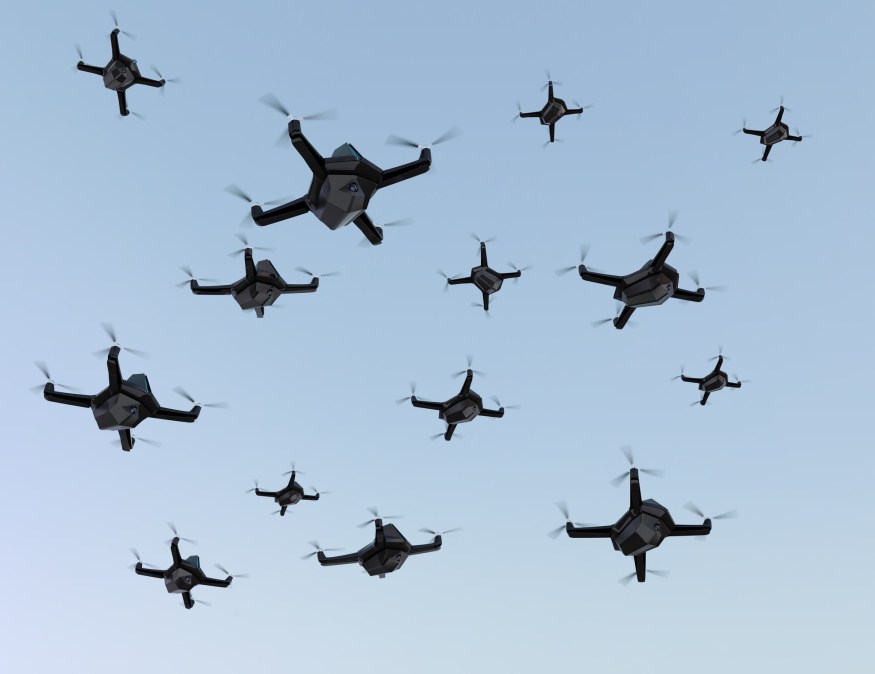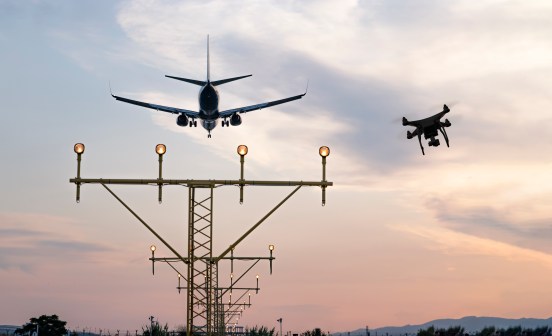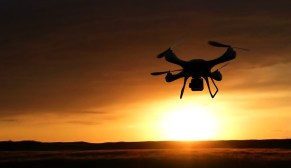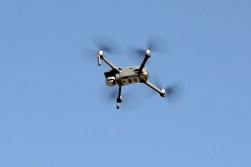Bill would prod Pentagon to accelerate fielding of new tech to defeat drone swarms

The Senate Armed Services Committee’s version of the fiscal 2023 National Defense Authorization Act calls for the Pentagon to come up with a new strategy for fielding systems capable of defeating swarms of enemy drones that U.S. troops may face on future battlefields.
The text of the legislation, released last week, includes a number of provisions aimed at addressing the emerging threat. While the Department of Defense has already set up a Joint Counter-small Unmanned Aerial Systems Office (JCO) — lawmakers want the Pentagon to do more to improve the military’s ability to defend against large numbers of drones conducting coordinated attacks against U.S. assets.
“The proliferation of unmanned aerial systems and the ability to operate them in swarms poses a significant threat to the Joint Force. The committee applauds the Department of Defense’s focus on rapid development and fielding of counter-UAS capabilities, but seeks to accelerate fielding of capabilities that could counter UAS swarms,” the SASC said in its report on the authorization bill.
The bill would direct the secretary of defense to develop and implement a new strategy to field systems to address the threat, to include the creation of a comprehensive definition of ‘‘unmanned aerial system swarm’’ and a plan to establish and incorporate requirements for development, testing, and fielding of counter-swarm capabilities.
The legislation would require the Pentagon leadership to conduct an assessment of the threats posed by drone swarms to DOD installations and deployed military forces; an analysis of the use or potential use of swarms by adversaries, including China, Russia, Iran, North Korea and non-state actors; and an analysis of enabling technologies such as autonomy and machine learning.
It would also mandate a review of current fielded systems and whether they effectively counter a wide range of potential drone swarm threats; an overview of DOD development efforts and field tests of technologies that offer “scalable, modular, and rapidly deployable” C-UAS tools; and a plan to acquire and field adequate “organic capabilities” to counter drone swarms in defense of U.S. military forces, assets and infrastructure across land, air and maritime domains.
Additionally, it would direct the Pentagon to provide an estimate of the resources that would be required for the Army, Navy and Air Force to implement the plan.
The bill includes a deadline of no later than 270 days after the enactment of the legislation for the secretary of defense to submit to the congressional defense committees a report on the findings of the Pentagon’s analysis and the strategy to address the threat.
Lawmakers highlighted the potential of directed energy weapons to defend against large numbers of drones. The Pentagon has been testing a variety of these types of systems in recent months — although not always against the large numbers of UAS that some policymakers and analysts expect the U.S. military could face in the future.
“The committee supports the current efforts of the military services to develop an array of high-powered laser and microwave directed energy weapons for land, sea, and air applications. By achieving higher power levels, near continuous shot availability, and low downtime for recharge or heat dissipation, these systems aim to effectively defeat hardened and swarming threats,” according to the SASC bill.
“The committee encourages the military services to incorporate components from these newly demonstrated technologies into ongoing directed energy research and development to facilitate deeper magazine and higher power levels with reduced size and weight,” it added.
Notably, the legislation would authorize a $9.8 million boost in R&D funding for the design of “high-powered amplifiers and innovative signal conditioning circuits” that could aid radar detection and the use of directed energy systems for defeating drones.
“The committee is aware that improved long-distance radar detections and swarm counter-unmanned systems (c-UxS) are both critical capabilities for the Department of Defense. The committee is also aware that research measurements for transmitted long-distance power density of phased arrays are often challenging,” the bill noted.
When it comes to directed energy, lawmakers are “concerned that demonstrated high duty cycle technologies with significant size, weight, power, and cost effectiveness are underutilized in the scope of current developments, with services settling for more limited shot time, power level, and mobility,” the bill said.
By March 1, 2023, the legislation would direct the secretary of defense to provide the congressional defense committees a briefing on “how recently demonstrated capabilities at the 100kW level and above compare with the technologies currently being developed and evaluated by the military services and how incorporation into current directed energy programs will impact critical factors, including cost, schedule, size, weight, power, operationally relevant testing, and mission flexibility. The briefing shall also describe existing technological gaps that may prevent integration of more capable subsystems.”
Meanwhile, members of the House Armed Services Committee are also sounding the alarm about the threat posed by enemy drone swarms.
“The threat posed by swarming sUAS grows alongside the need to improve system dependability and defensive networking capabilities,” the HASC said in its report on its version of the NDAA, noting that high-powered microwaves (HPM) could help address the problem.
“The committee encourages the Army to ensure full consideration of HPM systems as part of a layered defense for protection of fixed and semi-fixed sites. The committee further encourages the Army to include requirements for scalability and modularity in development of such systems,” the report said. The Army is the executive agency for the Pentagon’s joint counter-small UAS efforts.
The legislation would direct the secretary of the Army to provide a briefing to the HASC no later than Feb. 1, 2023, on a strategy to develop and test “scalable, modular High Power Microwave systems that can be integrated into the Army’s air defense battle command system, as well as detect, track, identify, engage, and defeat sUAS swarms. The briefing should also include plans, if any, to produce and field this capability to equip forward deployed or expeditionary units.”
The House and Senate versions of the NDAA must be reconciled in committee before the annual defense authorization bill can be passed by Congress and signed into law by the president. The House has already passed its version of the NDAA, but the full Senate has not yet voted on its version. It’s not yet clear which counter-drone swarm provisions will be included in the final version of the fiscal 2023 legislation.




